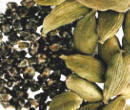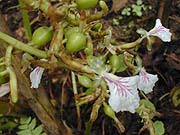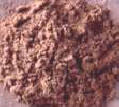Cardamom
Information about Cardamom plus Cardamom
Recipe Collection
Â
 |
Cardamom
is the seed of a perennial plant called Elettaria cardamomum which
belongs to the family Zingiberaceae (ginger family). One of the most
expensive spices in the world, second only to saffron, it has been used
for medicinal and culinary purposes for millennia
and is currently used in many cuisines the world over in both it's
natural and ground forms. |
Â
Origin
and History of Cardamom
Â
Cardamom is the
seed of a perennial plant known as Elettaria cardamomum which belongs to the
family Zingiberaceae (ginger family). One of the most expensive spices in the
world, second only to saffron, it has been used for medicinal, spiritual and
culinary purposes for millennia
and
is currently used in many cuisines the world over.
Â
Although native to
India, in particular growing wild on the Malabar Coast in the south, Â the
peoples of Mesopotamia, Persia, Egypt, and China have been aware of the benefits
cardamom both as a medicinal constituent and for culinary purposes as well as in
spiritual rituals for over 5000 years. It was grown in the garden of the king of
Babylon c721BC Â and mention of it as being a spice liable to duty in Alexandria
appears in lists dated 176-180AD. Â Â Â
Â
Alexander the Great�s
soldiers introduced it to Europe upon returning from India around 325BC and the
ancient Romans and Greeks not only used it in food and for medicinal purposes,
but also in perfumes. Â Indeed, it is said that Cleopatra had her palace perfumed
with Cardamom for Mark Anthony�s visits.
Â
The Normans first
introduced cardamom into England in the 11th century however it wasn�t until the
17th century that cardamom was imported to Europe on a regular basis with the
advent of easier trade routes by sea, Â set up by the Dutch, Portuguese and
British, rather than the laborious over-land routes
Â
Cultivation
and Processing Cardamom
Â
 The
Cardamom plant is a bushy perennial which grows up to 3m. They are found
growing in the wild mainly
in forests situated
between 800 and 1500 metres above sea level and require hot humid conditions.
Today, cardamom is cultivated, not only  in India but also places like Nepal,
Sri Lanka, Central America, Mexico and Thailand. They can be grown from seed or
vegetatively, using portions of the plant�s rhizomes and when cultivated are
grown in open fields or forests. The
Cardamom plant is a bushy perennial which grows up to 3m. They are found
growing in the wild mainly
in forests situated
between 800 and 1500 metres above sea level and require hot humid conditions.
Today, cardamom is cultivated, not only  in India but also places like Nepal,
Sri Lanka, Central America, Mexico and Thailand. They can be grown from seed or
vegetatively, using portions of the plant�s rhizomes and when cultivated are
grown in open fields or forests.
Â
Harvesting can start
in the plant�s third year and is generally done when the fruit is 2/3rds ripe
and still green. The pods which contain around 20 seeds are hand picked and then
dried, traditionally in the sun but nowadays sometimes mechanically, after
which they are sorted and graded. Pods which don�t have the uniform green
colour are often bleached
using bleaching powder, sulphur
dioxide or hydrogen peroxide however this results in a loss of flavour.
Â
Any pods which are left to ripen
more, thus losing their green colour can also be harvested, Â however these tend
to burst open more readily resulting, Â in a loss of essential oils and are
therefore, once again, less flavoursome. Once the sorting has taken place, they
are either used whole or ground.
Â
Buying and Storing Cardamom
Â
 If
possible, buy the whole seeds and grind them yourself as needed. Apart from the
fact that some bought ground cardamom is mixed with other ingredients to bring
down the cost, once ground, Cardamom loses its aroma and flavour much more
quickly. Choose the greener ones as these have the best flavour . If
possible, buy the whole seeds and grind them yourself as needed. Apart from the
fact that some bought ground cardamom is mixed with other ingredients to bring
down the cost, once ground, Cardamom loses its aroma and flavour much more
quickly. Choose the greener ones as these have the best flavour .
Â
As with most other
spices, both whole and ground cardamom should be stored in an airtight
container. Cardamom pods will last for many months.
|
|


 The
Cardamom plant is a bushy perennial which grows up to 3m. They are found
growing in the wild mainly
The
Cardamom plant is a bushy perennial which grows up to 3m. They are found
growing in the wild mainly